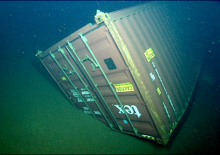A containers pivotal role in Robert Redfords new movie, All is Lost

Donate Now!
Your contribution will benefit Friends of the Earth.
Stay Informed
Thanks for your interest in Friends of the Earth. You can find information about us and get in touch the following ways:
A harrowing new film entitled All is Loststarring Robert Redford, whose character tests his mettle against the sea, features an item familiar to many in the maritime and logistics communities: the shipping container. I’ve yet to see the movie, but the trailer starts out with Redford’s character’s yacht being punctured by an overboard container and the vessel taking in water. Although the risk of this occurring in real life is minor, it does happen—and is quite a scary thought. And with more and more container ships plying their trade in seas around the globe, the number of container losses is likely growing. In fact, a major incident occurred just a couple weeks ago, with a Maersk vessel losing around 520 containers in the Bay of Biscay. While reporting requirements to government agencies regarding at-sea container losses are limited (e.g. hazardous substances) and no comprehensive, global accounting takes place, one can infer, based on reports and media accounts, that annual container losses are in the thousands, and might be as many as 10,000. (The World Shipping Council, which represents container lines, puts the figure at between 350 and 675 lost containers a year.) With over 160 million containers carried in seaborne trade annually, though, the loss of several thousand containers each year is not hard to imagine, especially as there is little financial incentive to significantly alter behavior, since container losses are covered by insurance and typically (e.g. non-specialized containers) do not warrant large payouts.
In addition to safety of navigation dangers posed by lost containers, the actual contents of the container, once released, can be ingested by, coat, or ensnare marine life, resulting in harm. Even innocuous-looking consumer goods and packaging materials, when broken down into small pieces, can be detrimental to biota. Also, research by scientists indicates that sunken containers within the Channel Island National Marine Sanctuary have affected seafloor habitat.
Much can be done, however, to substantially reduce the number of containers lost at sea and mitigate impacts presented by those losses. A good initial step has recently been taken at the International Maritime Organization (IMO)—the U.N. specialized agency for shipping—by requiring the verification of container weights prior to loading, and with a proposed rule by the U.S. Coast Guard mandating cargo securing manuals on many vessels. But more needs to be done, at the IMO, regionally (e.g. European Union), and/or nationally. We suggest the following:
– First, more stringent standards related to lashing (the tying down of containers), stack height, and vertical weight distribution could be imposed.
– Second, in the case of an overboard container event, the ship owner or operator should promptly notify the proper authorities, provide incident location coordinates, and describe the nature of container contents at issue, even if non-hazardous.
– Third, a global database of overboard containers ought to be maintained.
– Fourth, tracking devices could be affixed to containers that are most susceptible to falling overboard, which could facilitate their recovery as well as enable ships to avoid them.
– Finally, salvage of overboard containers should be attempted, if practicable.
Friends of the Earth, through its international federation Friends of the Earth International, has a seat at the IMO—one of the handful of environmental organizations with consultative status at the Organization. We will continue to shed light on important, little-covered subjects such as these, as well as seek sensible policy solutions.
Photo credit: NOAA
